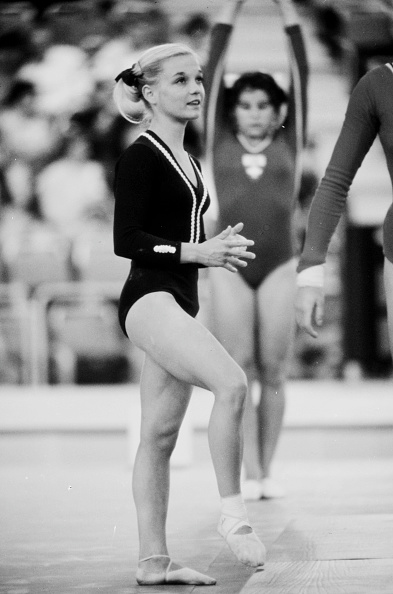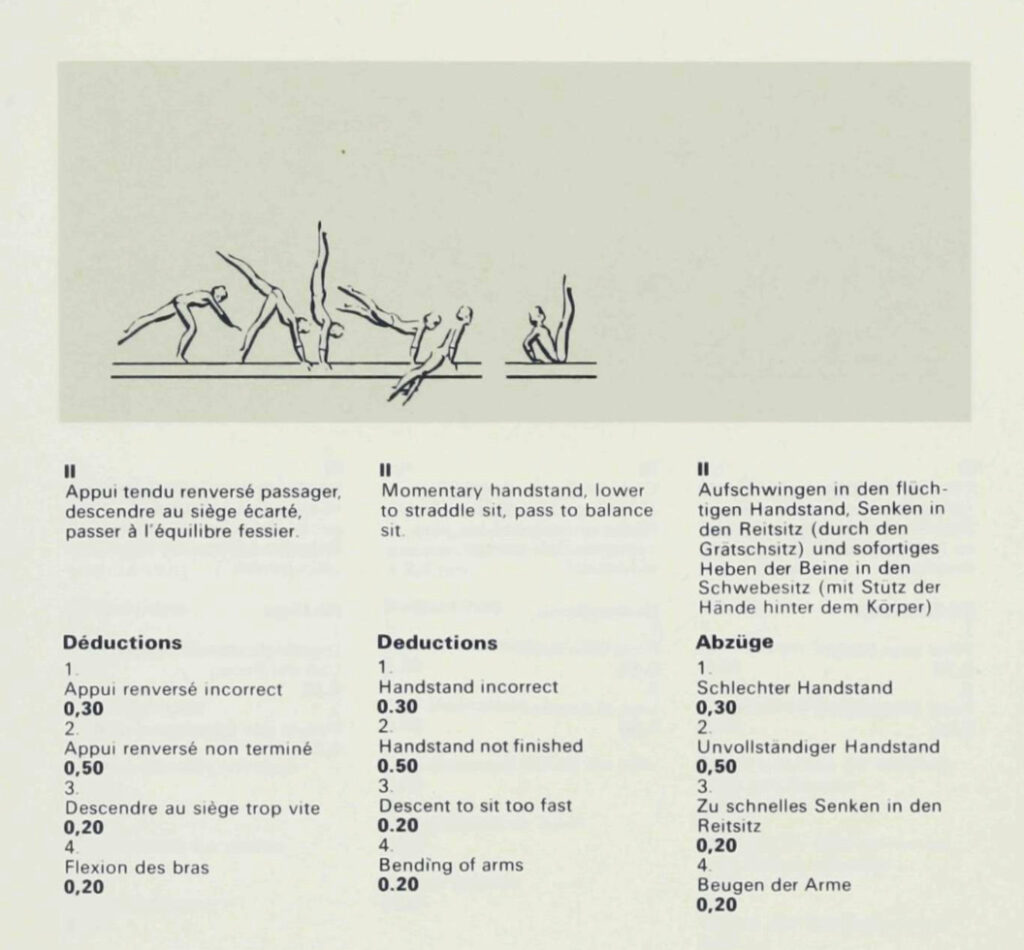At the 1948 Olympic Games, the U.S. women took home the bronze medal. 24 years later, the U.S. women almost found themselves on the podium again. They took fourth place — 2.35 points behind the Hungarian team. Yet, many U.S. members of the gymnastics community felt that they should have been third.
Here are a few of the reactions.

Quick Links: ABC’s Coverage | International Gymnast’s Coverage | Jackie Fie’s Analysis of the Judges’ Scores
ABC’s Coverage
ABC’s coverage focused on Cathy Rigby’s “failures.”
Chris: [00:00:00] The United States Girls’ Gymnastics team finished a very respectable fourth. However, Cathy Rigby did not qualify for the finals in her favorite event, the balance beam. Our busy colleague, Jim McKay, was there for a report.
Jim: Chris, certainly one of the big disappointments of these Olympics so far for the United States was the failure last night of little Cathy Rigby to qualify for the final in her specialty, the balance beam. A couple of things can be said about it. There were a couple of reasons for it. One was [00:00:30] that in general, all around, Cathy’s performance here simply didn’t come up to what she did at the World Championships two years ago, nor what she has been doing in the United States before our own Olympic trials came along. For example, in the compulsory action, which took place on Sunday here, this was Cathy in her specialty, the balance beam, doing a comparatively easy cartwheel and making a mistake. A mistake that almost threw her completely off the bar [sic].
In fact, it was a near-miraculous recovery that she made, as you can see here, to get back [00:01:00] into action, and complete the routine. She not only completed it, but she did come up with a mark of 9.25. Well, that took us to last night and the optional part of the balance beam. Normally this is Cathy Rigby’s most spectacular performance but in doing this last night, she left out a key part, Cathy Rigby watching with some tension, I should think, as the Czechs and Hungarians perform here to see if our girls can hang on. Cathy, did you leave out, one move in the balance beam tonight, [00:01:30] perhaps intentionally?
Cathy: Yes, especially because I wanted for team points, and if it’s possible to make beam finals, then I’ll put in the aerial, but I’d rather see our team take third than chance it and miss.
Jim: In other words, by leaving out the aerial, you might have endangered your own chances of getting into the balance beam final, but you did it for the team’s chances of getting a bronze.
Cathy: Yes, I hope. Well, we’re hoping for it. Right now we don’t know because [00:02:00] the Hungarians and Czechs have three more events.
Jim: Well, we hope you get the medal and we hope you get to the final too.
Cathy: Thank you very much.
Jim: Well, that brings you up to the minute on the Cathy Rigby story. She will not be in the balance beam final. She will tomorrow night, however, perform in the–
[00:02:17] [END OF AUDIO]
On the topic of Cathy Rigby: Some believed that her nude photos in Sports Illustrated hurt the U.S. team’s chances of a medal. Arthur Gander publicly expressed his disappointment.
Various opinions as to the state of US women’s gymnastics in the eyes of the rest of the world were received, all of which gave us high praise. Among the thoughts offered, however, were better coaching (in terms of psychological management of the team), more individualized coaching (apparently the Russians trained separately with their own coaches for much of the interim after their Olympic Trials), and less publicity of the Sports Illustrated variety. It was questionable as to how much the SI article hurt Cathy when the whole team was being underscored by the judges, but the unfavorable opinions held by Arthur Gander and others of the FIG were spread throughout the Munich newspapers, and this could not fail to affect the outcome.
Gymnast, Nov. 1972
You can read more about the photos and Gander’s reaction here.
Gymnast‘s Coverage
The coverage of Gymnast focused on the judging of the Eastern bloc, alleging that the judges from communist countries banded together to ensure that the U.S. did not land on the medal podium.
With respect to the women’s competitions, Tom Maloney, as reported in the AAU Gymnastics News wrote, “Our women’s team was definitely a better team than the Hungarians who won the bronze for third and our team was terribly underscored on optional beam and uneven bars. It is most discouraging to see o her teams who are not in contention for a medal doing a basically stock routine with no risk and yet they receive high scores. The answer here has to be that because they are not in contention for a medal the judging is very liberal. The Communist judges who work together to aid all Communist nations not only refuse to give our girls the scores they deserve but also deliberately shave points and give as low a score as is possible.”
The opinion that the US women deserved 3rd place at the end of the team competition was shared by several international experts. Ms. Liese Neimeyer of the Deutscher Turnerbund press department wrote, “Never did a US women’s team perform at Olympic or world games as convincingly as the 1972 team did in Munich. This tribute must be paid to them before entering on details because they had every reason to be dissatisfied with their overall scores. More than any other team they were handicapped by bad luck in belonging to the second of the five compulsories competition groups, and there were ever so many cases of underscoring.”
Dr. Joseph Gohler, Editor of the Olympishe Turnkunst: “If there was anything to complain of it was the scoring. One of the reasons for unfair scoring always provoking shrill whistling of the 12,000 spectators was the deplorable fact that some judges, male and female, were not able to discard national prejudice, and another and more frequent reason being the slackening of judging standards in the course of competitions. Scores in the evening were milder than in the morning, with competitors that had to perform early losing valuable tenths. The US girls were among those luckless, thus narrowly missing the bronze medal though experts were unanimous that they were better than the Hungarians… ln spite of their handicap of belonging to an ill-favored competition group, five of them had qualified (for the all-.around competition) with Nancy Thies missing the limit by a bare twentieth of a point… On their respective Munich showings the US girls have stolen a march on the likeable US boys. “
Gymnast, Nov. 1972
Jackie Fie’s Analysis of the Scoring
Jackie Fie, who would later become President of the Women’s Technical Committee, judged compulsory beam and optional floor. When the judges’ scores were made public, she analyzed them, and something stood out to her.
The superior judges gave higher scores to the U.S. gymnasts than what they received. There was one exception. Valerie Nagy, the head coach of the Hungarian team and the newly elected President of the Women’s Technical Committee, tended to score the U.S. gymnasts lower, particularly on compulsory beam.
Fie believes that Nagy gave all the U.S. gymnasts a deduction that was not specified in the rules.
[Nagy] deducted for a swing down from the handstand to a v-sit for no hand placement behind the hips. Now, it seems that her deduction was approximately .3 for each girl (looking at her scores). The East Germans placed only one hand on the beam following the swing down and they had the other hand stretched forward in line with the rear arm and they were not deducted at all. No mention was given during any FIG Technical Committee meeting that this was mandatory. The only instruction that we received was that the handstand position had to be retained, stretched, held, or marked, the arm position during the swing down had to be stretched, the arms straight, and there must be a certain amount of control during the swing down to the v-sit.
If Madame wouldn’t have deducted for this, it would have added 1.50 to her score which would have made us only two-tenths lower than what we actually received (45.60). There was not one other judge on that panel that deducted for that, but she stuck to her guns that this was an infraction of the rules.
Gymnast, Nov. 1972
As the head judge, Nagy’s scores would not have been factored into the final scores for the U.S. gymnasts. According to the 1970 Code of Points, she was not supposed to communicate her scores to anyone else except in the case of a conference.
Nevertheless, Fie was making the argument that based on the scores of the head judges—supposedly the authorities on judging—the American gymnasts were better than the Hungarians:
I’m going to give you the scores that the head judges scored us …. not the average scores …. and this is going to support the feeling that was conveyed to me by the authorities in Europe, that we were, indeed, the better team.
Gymnast, Nov. 1972
You can read Jackie Fie’s full report below.
Note: While the drawings show the gymnast with her arms behind her on the balance sit, no explicit deduction is listed for not using one’s hands during the element. (More on the compulsory routines here.)

More on 1972